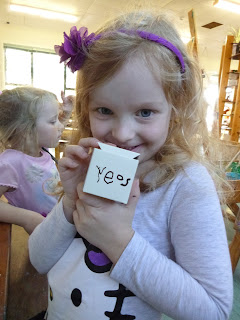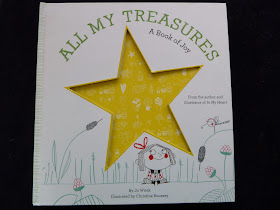Who doesn’t remember the
magic as a child, of watching the transformation of tadpoles slowly turning
into frogs. At Mairtown we were lucky enough all of last term to have had some
tadpoles to look after. It hasn’t been an easy journey at times, we have had a
few deaths (!) but it has certainly been a great learning experience for all of
us. This post tells a story of our inquiry together.
When our tadpoles first
arrived, thanks to Kelsey and Lachlan, most were small with no legs. Rather
than immediately tell the children what they were, when I’m working with
children in small groups, I like to encourage them to inquire, to ask
questions, to answer these questions, to tell stories and work out the ideas
that are flowing through their minds. This is the basis of inquiry based
learning, and one that I love and value as a teacher.
We have found at Mairtown
that the most authentic learning comes from experiences that are guided by the
children. We don’t have ‘themes’ that we push into our programme, rather we
observe what fascinates the children together and with them we negotiate the
next steps of learning.
When the tadpoles arrived,
Lachlan who had brought them in was clearly enthusiastic, and it was his enthusiasm
and current knowledge that soon drew a small group of other children wanting to
share in the experience and learning. Rather than announcing they were
tadpoles, the first thing we did as a group was to discuss what we saw. My
questions for the children, to encourage their deeper thinking were ‘What
do you see? What do you think? What do you wonder?’ As we worked together I
documented some of the children’s ideas so we could re-visit these together throughout
the inquiry.

As always, I supplied some close-up
photographs of tadpoles to further provoke the children’s thinking, as well as
having access to the live tadpoles in front of us. As the children started to
reflect and share their ideas I was ready with an assortment of materials for
them. Loris Malaguzzi the founder of the Reggio Emilia approach to education
felt it was important for the art studio to be subversive; a combination of
both an art studio and a science laboratory. This is evident each time I work
with children and provide tools for their exploration - whether it be clay,
paints, pen and paper – these media are helpful for children when working out
their ideas, hypothesizing, testing theories, answering questions – and also a
way for them to document and record their own learning.
‘Documentation
also enables young children to see their own thought processes. When children
speak, write, draw, build, or dramatize their ideas, they are making their
thinking visible.’ (Salmon, 2010)
In this recent work, the
children worked with white paper, black vivid and at times dye. Here is an
extract from their initial thinking in the first week of the tadpoles arriving (early February 2017).
Me: What do you see?
Elsie: He’s got a tail and a body.
Tilly: And a little head.
Elsie: And a tiny little mouth. The tail goes waggle.
Tilly: And there are little stripes on the tail.
Elsie: It shakes its body; the body is like an olive.
Me: What do you think about this animal?
Tilly: I think it will turn into a snail.
Elsie: If that happens it’ll have to lose its tail.
Willow: Or maybe it’ll turn into a snake.
At this point, Lachie arrives and being the expert he is
on tadpoles, tells everyone ‘They are tadpoles, I have them at my house’ – but
Lachie didn’t tell everyone what happens next!
Me: What do you wonder now that you have heard they are
tadpoles?
Elsie: I know that tadpoles turn into frogs. I wonder when
it will be a frog, will it need a bigger pond? I think it will be a frog in one
week.
Archie: I wonder will it grow more. Will it grow 3 or 4
legs?
Tilly: I think it’ll be 2 legs at the front and 2 legs at
the back and then it can jump.
Archie: Do they bite?
Milla: No, as they don’t have teeth – see, I can’t see
teeth. They do look a bit like fish though.
Archie: This is what will happen. It’ll get more legs so
it can turn into a frog and then go ribbit ribbit.
During the weeks following the arrival of our first
tadpoles, we had a little challenge! Some of our tadpoles died; but again, this
opened up lots of dialogue for the children to think through. And each day I
encouraged any children who wanted to learn more about tadpoles into our small
group discussions. As the first few days progressed the children soon realised
we needed to find out more about how to care for our tadpoles. On the
children’s advice and guidance, we searched the internet for questions we thought
may help us provide a safe environment for the tadpoles, and also collected
some books from our local library.
When
thinking is part of their routine, children become alert to situations that
call for thinking (Salmon, 2010)
Looking through the books, many children observed and pointed
out how our tadpoles looked different to the pictures. Of course, as the days
went by, we all began to notice some changes happening – 2 legs turned to 4.
Lucas: Look, look! That one has 4 legs, some still have 2.
Piper: It’s trying to jump out, it’s trying to get out. We
need to be careful…don’t touch it
Elsie: His legs are folded up, they are getting bigger.
They are having a growth spurt. Now it’s bigger I can see they don’t have noses
so they don’t smell. Perhaps when it turns into a frog it will smell.
Zoey: How does the tadpole know when to turn into a frog?
Elsie: Because it’s got a good brain.

Our inquiry learning continued to develop and develop.
More children joined in our discoveries, while friends who had been interested
from day one, shared the learning they had learnt to date. One thing I love
about engaging in inquiry based learning, is that as teachers we are simply following
the students lead in their desire to find out more about their world. The
children inquire, they ask questions, and together we find out and think
through some of the answers. What is wonderful to see is how the children take
charge of their learning, it empowers them and they have clear ownership over
what they feel they need to, and want to, find out more about. Perhaps one of
the most important factors of inquiry based learning, especially in an early
childhood setting, is how our children know they are supported and hence feel
capable. For each child of course, the learning will look different, each
of them asking their own questions, then each of them all researching their
answers in different ways. Likewise, the understandings that they discover are
shown in a way that honours them and their individual learning needs. For instance,
some children will love to sit and discuss, some may draw, others create
stories, some will use clay, whilst again others may introduce this new leaning
into their imaginary and dramatic play.
By the end of February more changes were happening. One of
our tadpoles changed green and became a froglet. We had to think about the environment for our
emerging froglets, knowing they would be frogs soon, and again more research
took place into how we should care for our froglets. The observations of these
changes led to great thinking from the children.
 |
| Our tadpoles in their tank |
Elsie: They don’t have tails now, the patterns on its skin
is getting bigger.
Archie: No look, they still have a little bump for a tail,
but it’s mouth is bigger, like a happy face.
Milla: And its body is more square now.
Makenzie: Next time I come to kindy it will be a big frog.
Then of course, just as Makenzie predicted, our first
froglet turned into a frog, soon followed by the other froglets. This opened up
a whole new level of care for us as we needed to feed the frogs different foods. Through our research, we had discovered that
whilst froglets need no food, as they absorb energy from their tails, when they
become frogs they need an assortment of insects to eat. This job the children
took very seriously, and we spent many hours a week catching fruit flies (from
our worm bin with our homemade fly catchers) and hunting for passion vine
hoppers and small beetles. Many children caught bugs from home and brought them
in for the frogs to eat.
 |
| A tadpole with 4 legs |
 |
| An annotated drawing of our frog |
What did surprise all of us was watching how the frogs
ate. We all assumed they would stick a long tongue out to catch the flies, but
this isn’t what we observed in practice.
Milla: I was wondering how the frogs tongue gets so long
when it comes out.
Archie: Is that what happens when they eat flies? I
haven’t seen it happen yet.
Fernanda: Yes, they have big long tongues.
The watching began after this conversation – it was
several days until we were lucky enough to see a frog catch a live fly.
Arlo: It did it, it has a pink tongue, but it’s not big,
the fly came to the frog’s mouth and snap, it got eaten – it was so exciting.
Juno: I saw it, the fly was on the frogs nose, then frog
opened its mouth – fly gone.
 |
| A tadpole with 2 legs |
 |
| A frog |
As
children listen to each other’s ideas and see each other’s work, they have opportunities
to learn that there are different points of view. Through exploring a topic in
different ways and from different perspectives, they expand their
understandings’ (Kolbe)
 |
| Tadpole |
Unfortunately,
towards the end of the term, the day came when, after we had been discussing
how we could catch even more flies for the frogs (they were growing much bigger
and needing more food) that the children decided the frogs should live in a
pond so they could catch their own flies. This was such a thoughtful
response from the children, and a decision that everyone was happy with. So, late
March, two months after they joined us as very small tadpoles, we farewelled
our frogs into one
of our children’s ponds at home. We hope
they continue to grow big and who knows, maybe next year we may even get some
of their tadpoles back at kindergarten.
 |
| A froglet |
Hei konā mai,
Christine

















































